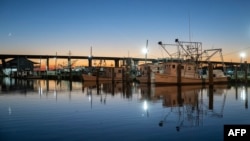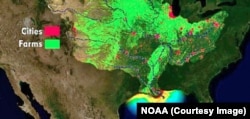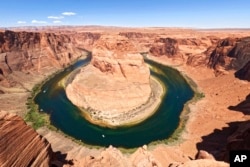Political leaders in the Mississippi River area are looking to form a multistate compact to manage threats from climate change, water pollution and drought-affected regions elsewhere.
“Twenty million people drink from the Mississippi River and its tributaries every day, including me and my family,” said Colin Wellenkamp, executive director of the Mississippi River Cities and Towns Initiative.
With the world’s fourth-largest basin, the Mississippi River supports more than 400 species of wildlife, has led to more than 350,000 jobs and generates more than $21 billion in annual tourism, fishing and recreation spending, according to the nonprofit group American Rivers.
“Whether you’re looking at it from a clean water standpoint, an ecological standpoint, a shipping of goods standpoint, or even from national security, there’s not a more important waterway in our country,” Wellenkamp told VOA. “We need to come together to protect and manage this critical resource.”
That’s what community and political leaders hope to do with a Mississippi River Compact to help unify lawmakers and residents along more than 3,700 kilometers (2,300 miles) of America’s most important river.
The compact’s framework would join 10 states in the collective management of river resources in consultation with stakeholders, including environmental groups, businesses and riverfront communities, to promote transparency and a shared sense of responsibility for the river’s well-being.
“When a farmer in a state upriver uses harmful fertilizer, for example, it affects the ability for fishermen to catch healthy fish at the bottom of the river in the Gulf of Mexico,” Wellenkamp said.
Nitrogen and phosphorus in runoff from lawns, sewage treatment plants, farmland and other sources along the river trigger algae blooms that choke off oxygen in water, killing marine life. Where the river meets the Gulf, that has caused a “dead zone” the National Oceanic and Atmospheric Administration estimates is costing U.S seafood and tourism industries more than $82 million per year.
“The problems facing the Mississippi River are many,” said Matt Rota, senior policy director at Healthy Gulf in New Orleans, Louisiana. “Only looking at the environmental side of things, we need to address water diversion protections, the Gulf dead zone, pollution, catastrophic flooding and — as we’re seeing right now in Louisiana — persistent droughts that are allowing saltwater from the Gulf to make our water undrinkable.
“These issues can’t be addressed state by state,” Rota continued. “They require a ‘whole river’ perspective. It’s vague right now exactly what a compact would cover, but there’s certain potential. From shipping to flooding to agriculture to wastewater disposal to drinking water and more, if a compact could prioritize the sustainability of the river, maybe it could help attract funds to help solve these problems.”
A “thousand-mile journey”
Tackling these challenges as a group could prove difficult.
“Solving the collective problems that span the river will require political cooperation among a very diverse group of states that don’t always agree on river management priorities, particularly around water quality issues such as nutrient pollution,” said David Strifling, director of the Water Law and Policy Initiative at Marquette University.
“Still,” he said, the “resolution to pursue the development of a Mississippi River Compact is the first step in a journey of a thousand miles.”
Wellenkamp acknowledged that states along the river do not always agree on what is best, “but when the river experiences record-breaking floods, we are all under threat. And when we have record-breaking droughts, we all suffer. When harmful chemicals find their way into the river up north, it hurts those of us in the South. And when manufacturing operations along the river in the south are hurting, it harms their headquarters in cities along the river in the North.”
In pursuing a compact, Strifling believes it is promising that political leaders in the Mississippi River Cities and Towns Initiative are rallying around issues that unify them, such as protections against diverting water to places outside the river basin.
Threat of “thirsty eyes”
The western region of the United States is experiencing a historic drought that U.S. Geological Survey data shows has resulted in a 20% drop in water flow along the important Colorado River over the last two decades. Kim Mitchell, senior policy advisor with Healthy Rivers, says the data suggests things could get worse in the years ahead.
“The U.S. Geological Survey is forecasting that the Colorado River could lose another 25 to 30% of its flow by 2050,” she told VOA, before offering a solution. “Conserving and using our existing water supply more efficiently is the cheapest and fastest way to meet the West’s water needs. The Colorado River has been pushed to its breaking point, and cities, farms, ranches, and businesses throughout the Basin will need to cut water use by at least 25%.”
Some western U.S. leaders, however, are looking at a different fix, one that includes shipping water out west from the Mississippi and from its large tributary, the Missouri River. Arizona Governor Doug Ducey last year agreed to spend $1 billion to investigate solutions that include pumping flood waters from the Mississippi River into the depleted Colorado.
“The idea of piping ‘excess’ Mississippi River water across the continental divide to supply water to the desert Southwest has persisted for decades no matter how unworkable it has been proven to be,” Trevor Russell, director of Friends of the Mississippi River’s Water Program, told VOA. “But not only would it just be a band aid for the problems being experienced out West, it would put the Mississippi River — America’s greatest river — at risk, too.”
That is where a Mississippi River compact could be especially beneficial.
“States with thirsty eyes have been wanting to put a straw in the Mississippi for years,” Wellenkamp said. “A Mississippi River Compact would finally put an end to that threat because no state along the river could give another state access to the river without the other states’ permission.”











